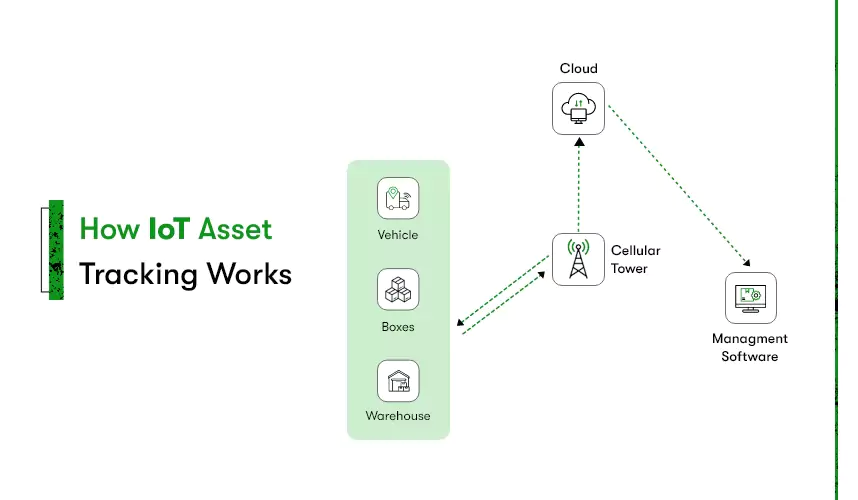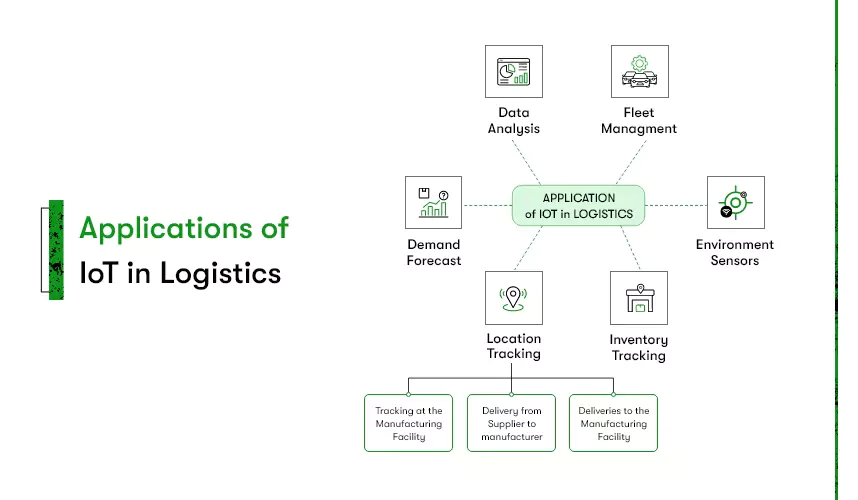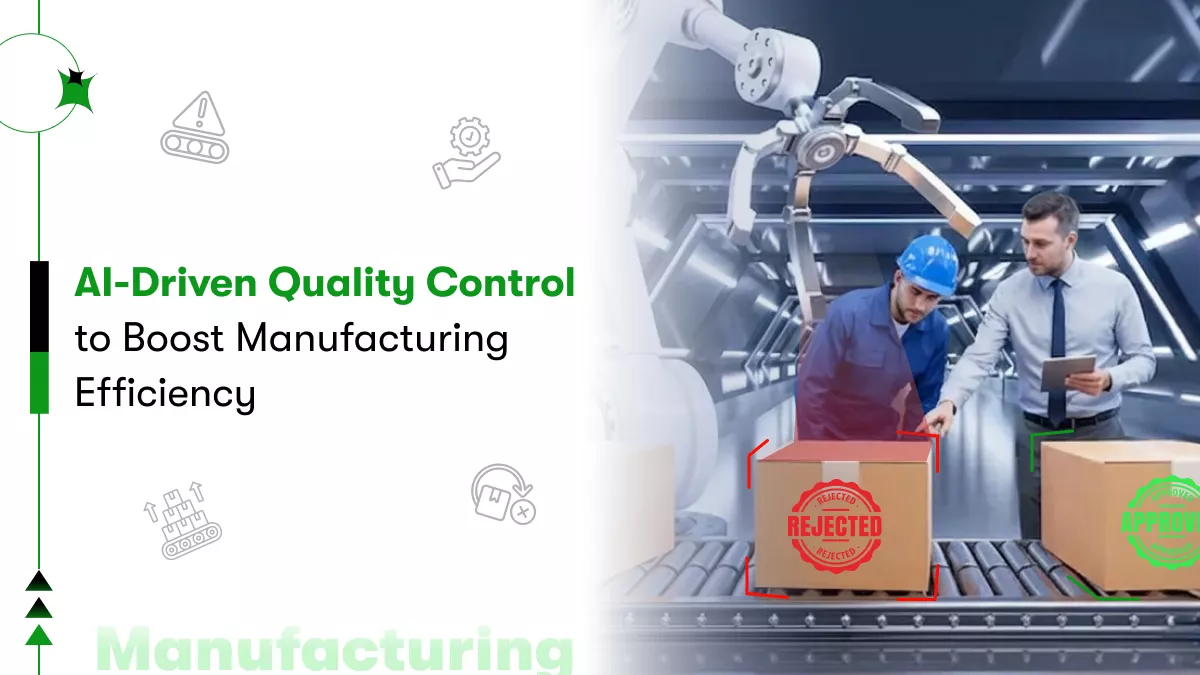Imagine a scenario in which you lose track of the whereabouts of your shipments. The ambiguity surrounding the location of your products could be dire for your business. Without real-time visibility and insights into shipment movements, you face a greater risk of product loss, late deliveries, and dissatisfied customers. All this can result in financial setbacks. In such situations, ensuring the security and expeditious delivery of products becomes virtually impossible. However, IoT asset tracking offers a game-changing solution to this issue.
It’s like having eyes in the back of your head, ensuring seamless logistics management. But what is it exactly, and how does it work in your favor?
What is IoT Asset Tracking, and How does it work?

Asset tracking with IoT refers to real-time surveillance of an asset’s location, condition, and status. Its primary objective is to ensure effective utilization, reduce losses, and expedite operations. With the evolution of IoT tracking sensors, asset monitoring has become more efficient, presenting businesses like yours with never-before-seen possibilities.
IoT tracking operates through various sensors and processors that transmit data to the cloud via a connectivity method, such as Bluetooth, Wi-Fi, cellular networks, LPWAN, RFID, and satellite. The data is then processed using software, and the resulting insights are relayed to the end user via an alert.
IoT Asset Tracking: Market Stats
At a CAGR of 11.6%, the global IoT asset tracking market is projected to reach $4.67 billion by 2023. In 2022, the transport and logistics segment held the largest market share at 32.5%. North America will contribute the most to the global IoT Asset Tracking and Monitoring market in terms of generating value.
Common Types of IoT Asset Tracking
However, there are numerous IoT Asset Tracking techniques available on the market. Therefore, we will now describe each technology and what you can look forward to from each!
Bluetooth
When the moving asset will always be in the range of devices that can receive its signals, Bluetooth Low Energy (BLE) is an excellent choice. BLE tags are desirable in a densely packed infrastructure due to their low cost and long battery life (up to 10 years).
Few Use Cases in Logistics:
- Warehouse Inventory Management: With real-time tracking, you can easily keep track of supply levels and receive notifications when supplies are running low. It assists you in managing your warehouse more effectively, but you will also receive valuable insights into your operations.
- Monitoring of Time-Sensitive Goods: You may establish expiry date reminders and prioritize shipping products that are about to expire, reducing waste and increasing efficiency. It can also monitor temperature, humidity, and other environmental conditions.
- Security and Access Management: If an asset or person enters an unauthorized location, you’ll be notified, allowing you to take appropriate action. This is vital for preventing theft, unauthorized access, and other potential security breaches.
Cellular
Many corporations choose cellular IoT Asset Tracking systems. It relies on standard cellular networks (3G, 4G, and eventually 5G) to provide precise position data across a vast area.
The rapid transmission of vast volumes of data is another advantage of cellular technology. Because of this, it may serve several purposes, including asset monitoring, over-the-air (OTA) updates and records, and more. The availability of cellular IoT makes it simple to include in existing gadgets.
Few Use Cases in Logistics
- Global Asset Monitoring: It delivers real-time data on the location and status of assets all over the world, making it suitable for firms with global operations. It provides dependable connectivity even in regions with inadequate Wi-Fi or GPS service.
- Cold Chain Surveillance: Cellular-based IoT asset tracking monitors temperature in real-time, alerting you to changes or breaches, preventing spoiling, and maintaining quality control. Furthermore, it records data for compliance, giving a trustworthy audit trail for satisfying regulatory standards.
- Asset Protection: Cellular asset tracking ensures continuous connectivity, real-time monitoring, and prompt notifications for asset safety. It is a virtual alarm system guarding against unauthorized access and theft. In the event of theft, the collected data supports investigations and insurance claims, increasing the likelihood of asset recovery.
Barcodes
Using asset management software with built-in barcode scanning capabilities is a viable option for the IoT asset tracking system. Barcode scanning enables this software to monitor the location and condition of assets and transmit that data to the rest of the IoT infrastructure.
Few Use Cases in Logistics
- Inventory Management: Barcodes allow for rapid tracking of items entering and exiting the warehouse, updating stock levels automatically. Improved inventory visibility makes it easier to identify slow-moving products, avoids stockouts, and optimizes warehouse space.
- Shipment Tracking: Barcodes make shipping tracking easier by delivering real-time information on package location. You can spot delays and take urgent action to ensure on-time delivery.
- Return Management: With a simple scan, barcodes enable a speedy return start, assuring efficient processing. Tracking returned products with each scan gives precise information, decreasing delays and increasing customer satisfaction.
Also Read: Optimizing Warehouse Processes with WMS!
RFID Tags
Since they only report their position when they cross certain checkpoints, Radio-frequency identification (RFID) tags are an example of passive IoT asset tracking. These tags broadcast a signal that a scanner can pick up at close range. Scanners may detect RFID tags from as close as a few centimeters or as far as 800 meters, depending on the settings you choose. A scanner will return a “positive read” if it comes into contact with an RFID tag.
Few Use Cases in Logistics
- Tracking Pallet and Case Levels: RFID tracking allows for rapid monitoring of pallets and cases, giving inventory management real-time visibility. Automated scanning saves time and assures accuracy, allowing you to optimize processes with certainty.
- Warehouse Automation: RFID tracking automates warehouse management, decreases manual mistakes, and saves time on inspections. Storage, order fulfillment, and productivity all benefit from real-time visibility.
- Proof Of Delivery (POD) Verification: RFID tracking automates evidence of delivery, resulting in indisputable digital records. There will be no more laborious paperwork or conflicts; real-time updates will establish consumer trust by providing exact delivery information.
LPWAN
The Low-Power Wide-Area Network (LPWAN) is a method of asset tracking that uses less energy and data across a large geographical region. The Internet of Things (IoT) relies on LPWAN, a specialized cellular communication explicitly developed for the sector. Creating private networks and linking gadgets in out-of-the-way places are two of its most common uses. The method is simple to implement, scalable, and requires little hardware maintenance over a 20-year lifespan on low-cost transmitters.
Few Use Cases in Logistics
- Predictive Maintenance: Long-distance, low-power networking through LPWAN allows for continuous monitoring of machinery health. Real-time data combined with sophisticated analytics forecasts maintenance requirements, avoiding costly failures.
- Geofencing: The long-range coverage and low power consumption of LPWAN allow for simple geofencing for asset security. Physical barriers are less of an issue with LPWAN technology, and it uses less power, providing steady and exact tracking.
- Connection in the Remote Area: You may overcome connection limitations in remote places by using LPWAN. The low-power feature of LPWAN allows devices and sensors to run over extended periods without the need for regular battery changes.
How is IoT Asset Tracking a Boon for Logistics Business?

IoT tracking devices and the appropriate software solutions may significantly enhance the vital business process of asset tracking. Tracking assets with the use of IoT asset monitoring provides several advantages, including:
Operational Optimization and Cost-Savings
By leveraging IoT asset monitoring and real-time data insights, you can improve the efficacy of your logistical operations. Additionally, it can result in substantial savings on costs. IoT asset tracking allows for predictive maintenance. It accomplishes this by continuously monitoring asset condition and performance. As it enables early detection of prospective problems, you can schedule proactive maintenance. It helps reduce unplanned downtime and maintenance expenses.
Real-Time Visibility
Having a constant inventory of the whereabouts of your assets may provide invaluable information for running logistics operations smoothly. IoT sensors and linked devices offer real-time, accurate data on the whereabouts, conditions, and inventory performance at any point in the supply chain. With up-to-the-minute information, you can prevent delays by anticipating problems, adjusting routes, and making well-informed choices.
Data-Driven Innovation
As we have seen, asset tracking with IoT may provide a lot of practical, accurate data. You may utilize this data to fine-tune processes, eliminate redundancies, and spot problem areas. In addition, it also provides improved communication and decision-making because access to real-time data is a crucial factor in developing robust partnerships and supply chains.
Thanks to IoT tracking sensors, it gives insightful data on how things are running. You may drive innovation and maintain competitiveness by analyzing this data and implementing continuous improvement activities.
Enhanced Security
Equipping assets with IoT tracking devices and sensors lets you monitor their whereabouts and status in real-time. This improved ability to monitor and trace shipments helps ward against theft, unauthorized access, and tampering. IoT asset tracking solutions’ geofencing features let you define virtual limits and get real-time notifications if your assets deviate from their predetermined paths or reach prohibited zones.
IoT asset management solutions do more than prevent theft. During shipping, IoT tracking sensors can check on the condition of the goods. During the trip, it guarantees the safety and integrity of high-value or temperature-sensitive cargo.
Fleet and Inventory Management
IoT asset management solutions provide a more comprehensive and adaptable technique for controlling fleets and stocks than conventional tracking methods. Understanding the efficiency of your fleet and where your assets are located gives you a competitive edge. This degree of detail in the data allows for data-driven decision-making, which improves fleet efficiency and saves money by optimizing routes and decreasing fuel usage.
IoT asset tracking also adds a new level of accuracy to inventory management. Real-time information on stock quantities, location, and condition is essential for optimizing inventory management, reducing stockouts, and avoiding overstocking to achieve a lean and agile supply chain.

Success Stories: IoT Asset Tracking In Action
Several tycoons and large businesses have implemented IoT asset tracking and reaped the benefits of doing so. Here are a few examples of known IoT tracking system implementation success stories
Amazon
The e-commerce titan has investigated IoT tracking in its warehouses and delivery operations. Amazon has utilized IoT asset tracking in the following ways and reaped the following benefits:
- Amazon employs IoT tracking devices such as RFID (Radio Frequency Identification) tags and sensors to monitor the movement of products throughout its extensive network of warehouses.
- Amazon’s delivery operations extensively use IoT asset tracking to monitor shipments from the warehouse to the customer’s doorstep.
- Amazon has been dabbling with IoT-enabled smart shelving equipped with IoT tracking sensors that detect when products run low and initiate automatic reordering processes.
- Amazon optimizes delivery routes in real-time using IoT tracking data from delivery vehicles. This reduces delivery times, increases fuel efficiency, and ultimately reduces operational expenses.
Walmart
Walmart, like Amazon, has been actively utilizing IoT asset management solutions to enhance operational efficiency by using IoT sensors and RFID identifiers. Let’s examine Walmart’s advantages:
- Walmart uses IoT asset tracking to track customer behavior, product popularity, and inventory. Targeted pricing maximizes revenue and improves the customer experience by offering appropriate discounts.
- IoT asset tracking tracks Walmart’s energy usage. This data-driven method minimizes Walmart’s environmental impact, energy usage, and operating expenses.
- IoT asset tracking lets Walmart track expiry dates and product lifecycles. Intelligent replenishment systems use real-time data to estimate demand and alter purchasing amounts to reduce excess inventory and overstocking.
DHL
DHL, the world’s leading logistics and shipping company, has established IoT asset tracking to improve operations and provide new services. Some of how it benefits are listed below.
- Pharmaceuticals and perishables sent by DHL use IoT tracking sensors. DHL can immediately solve temperature issues using these sensors.
- DHL predicts car and aircraft maintenance via IoT. Sensors monitor engine health, tire condition, and fuel economy to anticipate maintenance concerns before they cause delays. DHL eliminates truck downtime and assures timely deliveries with proactive maintenance.
- IoT asset tracking allows DHL to geo-fence high-value on sensitive shipments. Geo-fencing creates virtual limits that generate real-time notifications when packages enter or leave.
- DHL monitors its environmental effect using IoT asset tracking. DHL can increase sustainability by measuring warehouse energy, fuel, and emissions.
Conclusion
The fact that behemoths like Amazon, Walmart, DHL, and others utilize IoT, indicates that this is a potent tool and technology. The data-driven nature of IoT asset management solutions means they can significantly benefit your logistics company.
We’re parting ways for now, but you have enormous power in your hands thanks to IoT Asset tracking. We suggest you contact us whenever you’re ready to design and implement cutting-edge IoT asset management solutions for your logistics business. Our professional staff is eager to work with you to achieve your goals.













 Contact Information
Contact Information